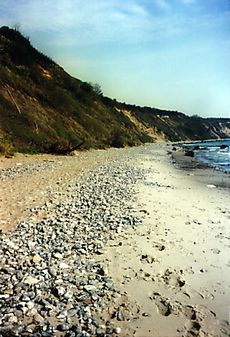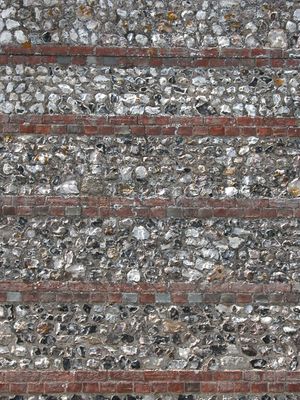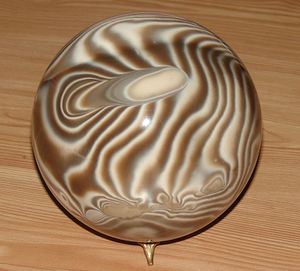صوان (حجر)
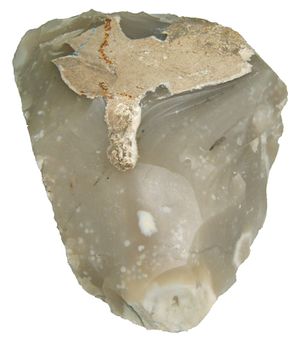

الصوان، هو حجر رسوبي خفي التبلور من معدن المرو، [1][2] يصنف كنوع من الشرت chert.It occurs chiefly as nodules and masses in sedimentary rocks, such as chalks and limestones.[3][4]عادة يكون الصوان داخل العقيدة باللون الرمادي الغامق، الأسود، الأخضر، البيض أو البني، وغالبا ما يكون ذو شكل زجاجي أو شمعي. والطبقة الرقيقة الخارجية في العقيدات عادة ما تكون مختلفة في اللون،فتكون بيضاء وخشنة الملمس. . From a petrological point of view, "flint" refers specifically to the form of chert which occurs in chalk or marly limestone. Similarly, "common chert" (sometimes referred to simply as "chert") occurs in limestone.
الأصل
يتشكل الصوان نتیجة عملية فيزيائية تتمثل في ترسب مواد معدنية (أملاح السيليكا) ذائبة في محاليل مائية مشبعة بمرافقة أملاح أخرى، والتي تصل إلى حالة "فوق الإشباع" نتيجة فقدان الماء وتبخره، فتترسب بالتالي المعادن الأقل قابلية للذوبان في الماء ثم تليها الأكثر انحلالا حول حبة رمل أو شوكة حيوان مائي أو أية "نواة تبلور" أخرى.
الاستخدامات
أدوات أو حواف القطع
كان حجر الصوان من أوائل المواد التي استخدمها البشر في العصور الحجرية لصناعة الكثير من أدواتهم، وذلك للخواص الفيزيائية المميزة لهذا الحجر من حيث القساوة والتشظي النمطي الذي يسهل صناعة أدوات ذات حواف حادة منه.
لإشعال النار أو البارود
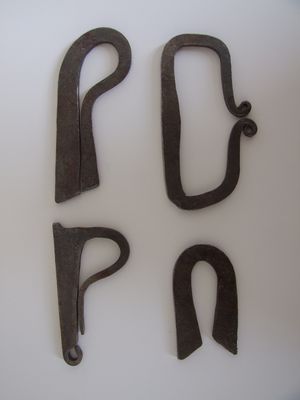
يستخدم حجر الصوان في إشعال النار، فهي أفضل الطرق البدائية الموجودة وذلك لإنتاج شرار مباشر ، قم بضرب حافة حجر الصوان بأي أداة معدنية ( كربونية ) ، حيث أن المعدن المصقول ( ستانلس ستيل ) لا ينتج شراراً بشكل جيد ، وتحتاج لأن يكون مفصل المعصم مرخي أثناء الضرب ، وعندما تشتعل المادة سريعة الاشتعال فإن الشرارة الناتجة تتحول إلى لهب.
يستعمل الصوان لإشعال النار فهو حجر أملس صغير يضرب لونه إلى الحمرة أو السواد. وفي لسان العرب: «الصَّوَّانُ:حجارة يُقْدَحُ بها، وقيل: هي حجارة سُود ليست بصلبة، واحدتها صَوَّانة. الأَزهري: الصَّوَّان حجارة صُلْبة إذا مسته النار فَقَّع تَفْقِيعاً وتشقق، وربما كان قَدَّاحاً تُقْتَدَحُ به النار»(3). وأضيف بأن حجر الصوّان إذا وضع في النار وتعرض للحرارة العالية فإنه يفقع ويتشقّق بالفعل.[5]
التفتيت
While flints may be used in fire-lighting they should not be exposed to heating by fire. Stone fracturing can result from uneven molecule expansion, causing fragmentation when cohesion is exceeded.[6]
أزرار أمان البندقية
A later, major use of flint and steel was in the flintlock mechanism, used primarily in flintlock firearms, but also used on dedicated fire-starting tools. A piece of flint held in the jaws of a spring-loaded hammer, when released by a trigger, strikes a hinged piece of steel ("frizzen") at an angle, creating a shower of sparks and exposing a charge of priming powder. The sparks ignite the priming powder and that flame, in turn, ignites the main charge, propelling the ball, bullet, or shot through the barrel. While the military use of the flintlock declined after the adoption of the percussion cap from the 1840s onward, flintlock rifles and shotguns remain in use amongst recreational shooters.
Comparison with ferrocerium
Flint and steel used to strike sparks were superseded by ferrocerium (sometimes referred to as "flint", although not true flint, "mischmetal", "hot spark", "metal match", or "fire steel"). This man-made material, when scraped with any hard, sharp edge, produces sparks that are much hotter than obtained with natural flint and steel, allowing use of a wider range of tinders. Because it can produce sparks when wet and can start hundreds or thousands of fires when used correctly, ferrocerium is commonly included in survival kits. Ferrocerium is used in many cigarette lighters, where it is referred to as "flint".
كمادة بناء
يعتبر الصوان أقوى أنواع الأحجار ولكنه صعب التشكيل ويجد العمال صعوبة في التعامل معه ، وهو موجود بكثرة في أسوان وسيناء ويوجد منه " أحمر – ذو حدود – أحمر قانى – أبيض ببقع سوداء – أسود ".[7]
Close-up of the wall of the Roman shore fort at Burgh Castle, Norfolk, showing alternating courses of flint and brick
Elaborate 15th century flint and limestone flushwork at Long Melford
A typical medieval wall (with modern memorial) at Canterbury Cathedral - knapped and unknapped ("cobble") flints are mixed with pieces of brick and other stones
Ruins of Thetford Priory show flints and mortar through the whole depth of the wall
Elaborate patterned flushwork at top (restored in 19th century) and flint and limestone chequers below. Norwich Cathedral
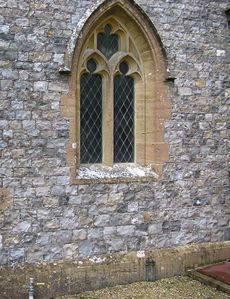
السيراميك
استخدم الصوان منذ العصور القديمة كمادة لبناء الجدران الحجرية، وذلك باستخدام جير الهاون، وكثيرا ما يكون مقترنا بالأحجار الأخرى المتاحة أو طوب الأنقاض (على سبيل المثال، قلعة بورگ في نورفولك التي بنيت في العصر الروماني المتأخر ).
المجوهرات
كانت أساور الصوان معروفة في مصر القديمة، وقد تم العثور على العديد منها. ويستخدم في الوقت الحالي الصوان المخطط كنوع من الأحجار الكريمة في المجوهرات.[8]
انظر أيضا
- المعادن
- Agate
- Chalcedony
- Chert
- Eolith
- Jasper
- Nodule (geology) not to be confused with Concretion
- Obsidian
- Onyx
- Opal
- Whinstone
- الآثار
- Ancient Egyptian flint jewelry
- Clovis Points, archaeological artefacts of the Clovis culture in نيو مكسيكو
- Grimes Graves, a prehistoric flint mine in Norfolk, England
- Flint Ridge State Memorial, a Native American flint quarry in Hopewell Township, Licking County, Ohio
- Flint mine
المصادر
- ^ General Quartz Information - Webmineral.com (page contains java applets depicting 3d molecular structure)
- ^ Flint and Chert - quartzpage.de
- ^ The Flints from Portsdown Hill
- ^ Flint vs Chert Authentic Artefacts Collectors Assn.
- ^ "النار: أدواتها.. وطريقة إشعالها". خيمة.
- ^ Scout Notebook - Building a cooking fire
- ^ "البناء بالحجر". منتدى كلية هندسة أسوان.
- ^ Graves-Brown, Carolyn. "AB29 Flint bracelet". Swansea University. Retrieved 13 January 2011.
وصلات خارجية
- Flint Architecture of East Anglia Book by Stephen Hart
- Flintsource.net European Artefacts - detailed site
- Flint circles and paramoudra - Beeston Bump
- Paramoudras and flint circles photograph collection
- Winchester Cathedral Close
- Flint and the Conservation of Flint Buildings Introduction to the historical use of flint in construction and the repair and conservation of historic flint buildings
